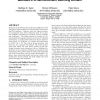212 search results - page 15 / 43 » Relational Instance Based Regression for Relational Reinforc... |
GECCO
2006
Springer
13 years 11 months ago
2006
Springer
Both genetic algorithms (GAs) and temporal difference (TD) methods have proven effective at solving reinforcement learning (RL) problems. However, since few rigorous empirical com...
HICSS
2003
IEEE
14 years 20 days ago
2003
IEEE
Basically, instrumental conditioning is learning through consequences: Behavior that produces positive results (high “instrumental response”) is reinforced, and that which pro...
ICML
2010
IEEE
13 years 8 months ago
2010
IEEE
Standard Reinforcement Learning (RL) aims to optimize decision-making rules in terms of the expected return. However, especially for risk-management purposes, other criteria such ...
DSMML
2004
Springer
14 years 23 days ago
2004
Springer
The equivalent kernel [1] is a way of understanding how Gaussian process regression works for large sample sizes based on a continuum limit. In this paper we show how to approximat...
ATAL
2007
Springer
14 years 1 months ago
2007
Springer
Temporal difference reinforcement learning algorithms are perfectly suited to autonomous agents because they learn directly from an agent’s experience based on sequential actio...

